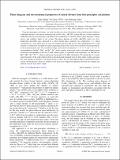Phase diagram and electrochemical properties of mixed olivines from first-principles calculations
Author(s)
Malik, Rahul; Fei, Zhou; Ceder, Gerbrand
DownloadMalik-2009-Phase diagram and el.pdf (447.6Kb)
PUBLISHER_POLICY
Publisher Policy
Article is made available in accordance with the publisher's policy and may be subject to US copyright law. Please refer to the publisher's site for terms of use.
Terms of use
Metadata
Show full item recordAbstract
Using first-principles calculations, we study the effect of cation substitution on the transition-metal sublattice in phospho-olivines, with special attention given to the Li[subscript x](Fe[subscript 1−y]Mn[subscript y])PO[subscript 4] system. We use a cluster expansion model derived from first-principles with Monte Carlo simulations to calculate finite-T phase diagrams, voltage curves, and solubility limits of the system. The phase diagram of Li[subscript x](Fe[subscript 1−y]Mn[subscript y])PO[subscript 4] shows two low-temperature miscibility gaps separated by a solid solution phase centered at Li composition x≈y, which corresponds to a state where most Fe ions are oxidized and most Mn are not. This intermediate low-T solid solution is stabilized by the dilution of phase-separating interactions caused by the disorder of redox potentials on the transition-metal sites. The calculated voltage curves show two plateaus at ~4–4.2 V and ~3.5–3.7 V, corresponding to the Mn(3+)/Mn(2+) and Fe(3+)/Fe(2+) redox couples, respectively, with an extended sloping region in between corresponding to the low-T solid solution phase. In agreement with experiment, we find that the Mn(3+)/Mn(2+) (Fe(3+)/Fe(2+)) voltage is decreased (increased) by Fe (Mn) substitution. We explain this by considering the energy of the solid solution which is the discharged (charged) state for these redox couples and argue that such changes are generic to all mixed olivine systems. We also find reduced phase transformation polarization on both plateaus which we attribute to the decreased composition difference between the oxidized and reduced state for each redox couple.
Date issued
2009-06Department
Massachusetts Institute of Technology. Department of Materials Science and EngineeringJournal
Physical Review B
Publisher
American Physical Society
Citation
Malik, Rahul , Fei Zhou, and Gerbrand Ceder. “Phase diagram and electrochemical properties of mixed olivines from first-principles calculations.” Physical Review B 79.21 (2009): 214201. © 2009 The American Physical Society.
Version: Final published version
ISSN
1550-235X
1098-0121